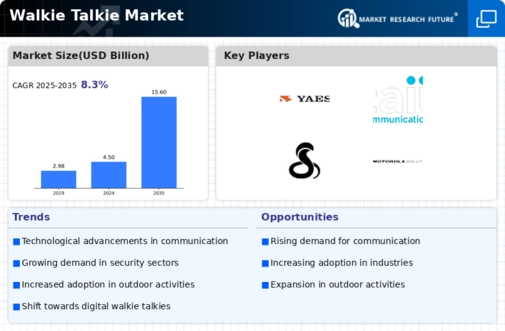-
EXECUTIVE SUMMARY
-
MARKET INTRODUCTION
-
DEFINITION
-
SCOPE OF THE STUDY
-
RESEARCH OBJECTIVE
-
MARKET STRUCTURE
-
RESEARCH METHODOLOGY
-
RESEARCH PROCESS
-
PRIMARY RESEARCH
-
SECONDARY RESEARCH
-
MARKET SIZE ESTIMATION
-
TOP-DOWN & BOTTOM-UP APPROACH
-
FORECASTING TECHNIQUES
-
LIST OF ASSUMPTIONS
-
MARKET DYNAMICS
-
DRIVERS
- USE OF DIGITAL WALKIE TALKIE FOR SECURITY PURPOSES
- COST-EFFECTIVE MEDIUM FOR SHORT DISTANCE COMMUNICATION
- DRIVERS IMPACT ANALYSIS
-
RESTRAINTS
- RANGE AND BANDWIDTH LIMITATIONS
- RESTRAINTS IMPACT ANALYSIS
-
OPPORTUNITY
- DEVELOPMENT OF TWO-WAY SMART RADIOS
-
COVID-19 IMPACT ANALYSIS
- ECONOMIC IMPACT ON THE MANUFACTURING INDUSTRY
- IMPACT ON THE COMMUNICATION AND BROADCAST INDUSTRY
- IMPACT ON WORLD TRADE
-
MARKET FACTOR ANALYSIS
-
VALUE CHAIN ANALYSIS
-
PORTERS FIVE FORCES
- THREAT OF NEW ENTRANTS
- BARGAINING POWER OF SUPPLIERS
- BARGAINING POWER OF BUYERS
- THREAT OF SUBSTITUTES
- INTENSITY OF RIVALRY
-
GLOBAL WALKIE TALKIE MARKET, BY TYPE
-
ANALOG
-
DIGITAL
- MARKET ESTIMATES AND FORECAST, BY TYPE, 2024-2032
-
GLOBAL WALKIE TALKIE MARKET, BY OWNERSHIP
-
LICENSED
-
LICENSE-FREE
- MARKET ESTIMATES AND FORECAST, BY OWNERSHIP, 2024-2032
-
GLOBAL WALKIE TALKIE MARKET, BY END USER
-
CONSUMER/PERSONAL USE
-
ENTERPRISES & COMMERCIAL
-
AEROSPACE & DEFENSE
-
LAW ENFORCEMENT & SECURITY
- MARKET ESTIMATES AND FORECAST, BY END USER, 2024-2032
-
GLOBAL WALKIE TALKIE MARKET, BY REGION
-
MARKET ESTIMATES AND FORECAST, BY REGION, 2024-2032
-
NORTH AMERICA
- MARKET ESTIMATES AND FORECAST, BY COUNTRY, 2024-2032
- MARKET ESTIMATES AND FORECAST, BY TYPE, 2024-2032
- MARKET ESTIMATES AND FORECAST, BY OWNERSHIP, 2024-2032
- MARKET ESTIMATES AND FORECAST, BY END USER, 2024-2032
- US
- CANADA
- MEXICO
-
EUROPE
- MARKET ESTIMATES AND FORECAST, BY COUNTRY, 2024-2032
- MARKET ESTIMATES AND FORECAST, BY TYPE, 2024-2032
- MARKET ESTIMATES AND FORECAST, BY OWNERSHIP, 2024-2032
- MARKET ESTIMATES AND FORECAST, BY END USER, 2024-2032
- UK
- GERMANY
- FRANCE
- NETHERLANDS
- BELGIUM
- GREECE
- RUSSIA
- ROMANIA
- UKRAINE
- REST OF EUROPE
-
ASIA-PACIFIC
- MARKET ESTIMATES AND FORECAST, BY COUNTRY, 2024-2032
- MARKET ESTIMATES AND FORECAST, BY TYPE, 2024-2032
- MARKET ESTIMATES AND FORECAST, BY OWNERSHIP, 2024-2032
- MARKET ESTIMATES AND FORECAST, BY END USER, 2024-2032
- CHINA
- JAPAN
- INDIA
- REST OF ASIA-PACIFIC
-
REST OF THE WORLD
- MARKET ESTIMATES AND FORECAST, BY COUNTRY, 2024-2032
- MARKET ESTIMATES AND FORECAST, BY TYPE, 2024-2032
- MARKET ESTIMATES AND FORECAST, BY OWNERSHIP, 2024-2032
- MARKET ESTIMATES AND FORECAST, BY END USER, 2024-2032
- MIDDLE EAST & AFRICA
- CENTRAL & SOUTH AMERICA
-
COMPETITIVE LANDSCAPE
-
OVERVIEW
-
MARKET SHARE ANALYSIS
-
COMPETITIVE BENCHMARKING
-
COMPETITOR DASHBOARD
-
KEY DEVELOPMENTS & GROWTH STRATEGIES
- PRODUCT LAUNCHES/PRODUCT DEVELOPMENT/SERVICE DEPLOYMENTS
-
COMPANY PROFILES
-
MOTOROLA SOLUTIONS
- COMPANY OVERVIEW
- FINANCIAL OVERVIEW
- PRODUCTS/SERVICES/SOLUTIONS OFFERED
- KEY DEVELOPMENTS
- SWOT ANALYSIS
- KEY STRATEGIES
-
GARMIN LTD
- COMPANY OVERVIEW
- FINANCIAL OVERVIEW
- PRODUCTS/SERVICES/SOLUTIONS OFFERED
- KEY DEVELOPMENTS
- SWOT ANALYSIS
- KEY STRATEGIES
-
COBRA ELECTRONICS
- COMPANY OVERVIEW
- FINANCIAL OVERVIEW
- PRODUCTS/SERVICES/SOLUTIONS OFFERED
- KEY DEVELOPMENTS
- KEY STRATEGIES
-
JVCKENWOOD CORPORATION
- COMPANY OVERVIEW
- FINANCIAL OVERVIEW
- PRODUCTS/SERVICES/SOLUTIONS OFFERED
- KEY DEVELOPMENTS
- SWOT ANALYSIS
- KEY STRATEGIES
-
ICOM INC.
- COMPANY OVERVIEW
- FINANCIAL OVERVIEW
- PRODUCTS/SERVICES/SOLUTIONS OFFERED
- KEY DEVELOPMENTS
- SWOT ANALYSIS
-
TAIT COMMUNICATIONS
- COMPANY OVERVIEW
- FINANCIAL OVERVIEW
- PRODUCTS/SERVICES/SOLUTIONS OFFERED
- KEY DEVELOPMENTS
- SWOT ANALYSIS
-
KIRISUN COMMUNICATIONS
- COMPANY OVERVIEW
- FINANCIAL OVERVIEW
- PRODUCTS/SERVICES/SOLUTIONS OFFERED
- KEY DEVELOPMENTS
- SWOT ANALYSIS
- KEY STRATEGIES
-
SHENZHEN HQT SCIENCE AND TECHNOLOGY
- COMPANY OVERVIEW
- FINANCIAL OVERVIEW
- PRODUCTS/SERVICES/SOLUTIONS OFFERED
- KEY DEVELOPMENTS
- SWOT ANALYSIS
-
UNIDEN HOLDINGS CORPORATION
- COMPANY OVERVIEW
- FINANCIAL OVERVIEW
- PRODUCTS/SERVICES/SOLUTIONS OFFERED
- KEY DEVELOPMENTS
- SWOT ANALYSIS
- KEY STRATEGIES
-
WINTEC CO., LTD
- COMPANY OVERVIEW
-
11.10.2FINANCIAL OVERVIEW
-
11.10.3PRODUCTS/SERVICES/SOLUTIONS OFFERED
-
11.10.4KEY DEVELOPMENTS
-
11.10.5SWOT ANALYSIS
-
11.10.6KEY STRATEGIES
-
YAESU
-
11.11.1COMPANY OVERVIEW
-
11.11.2FINANCIAL OVERVIEW
-
11.11.3PRODUCTS/SERVICES/SOLUTIONS OFFERED
-
11.11.4KEY DEVELOPMENTS
-
HYTERA COMMUNICATIONS CORPORATION LIMITED
-
11.12.1COMPANY OVERVIEW
-
11.12.2FINANCIAL OVERVIEW
-
11.12.3PRODUCTS/SERVICES/SOLUTIONS OFFERED
-
11.12.4KEY DEVELOPMENTS
-
11.12.5SWOT ANALYSIS
-
11.12.6KEY STRATEGIES
-
MIDLAND RADIO CORPORATION
-
11.13.1COMPANY OVERVIEW
-
11.13.2FINANCIAL OVERVIEW
-
11.13.3PRODUCTS/SERVICES/SOLUTIONS OFFERED
-
11.13.4KEY DEVELOPMENTS
-
11.13.5SWOT ANALYSIS
-
11.13.6KEY STRATEGIES
-
LIST OF TABLES
-
LIST OF ASSUMPTIONS
-
GLOBAL WALKIE TALKIE MARKET, BY TYPE, 2024-2032 (USD MILLION)
-
GLOBAL WALKIE TALKIE MARKET, BY OWNERSHIP, 2024-2032 (USD MILLION)
-
GLOBAL WALKIE TALKIE MARKET, BY END USER, 2024-2032 (USD MILLION)
-
WALKIE TALKIE MARKET, BY REGION, 2024-2032 (USD MILLION)
-
NORTH AMERICA: WALKIE TALKIE MARKET, BY COUNTRY, 2024-2032 (USD MILLION)
-
NORTH AMERICA: WALKIE TALKIE MARKET, BY TYPE, 2024-2032 (USD MILLION)
-
NORTH AMERICA: WALKIE TALKIE MARKET, BY OWNERSHIP, 2024-2032 (USD MILLION)
-
NORTH AMERICA: WALKIE TALKIE MARKET, BY END USER, 2024-2032 (USD MILLION)
-
US: WALKIE TALKIE MARKET, BY TYPE, 2024-2032 (USD MILLION)
-
US: WALKIE TALKIE MARKET, BY OWNERSHIP, 2024-2032 (USD MILLION)
-
US: WALKIE TALKIE MARKET, BY END USER, 2024-2032 (USD MILLION)
-
CANADA: WALKIE TALKIE MARKET, BY TYPE, 2024-2032 (USD MILLION)
-
CANADA: WALKIE TALKIE MARKET, BY OWNERSHIP, 2024-2032 (USD MILLION)
-
CANADA: WALKIE TALKIE MARKET, BY END USER, 2024-2032 (USD MILLION)
-
MEXICO: WALKIE TALKIE MARKET, BY TYPE, 2024-2032 (USD MILLION)
-
MEXICO: WALKIE TALKIE MARKET, BY OWNERSHIP, 2024-2032 (USD MILLION)
-
MEXICO: WALKIE TALKIE MARKET, BY END USER, 2024-2032 (USD MILLION)
-
EUROPE: WALKIE TALKIE MARKET, BY COUNTRY, 2024-2032 (USD MILLION)
-
EUROPE: WALKIE TALKIE MARKET, BY TYPE, 2024-2032 (USD MILLION)
-
EUROPE: WALKIE TALKIE MARKET, BY OWNERSHIP, 2024-2032 (USD MILLION)
-
EUROPE: WALKIE TALKIE MARKET, BY END USER, 2024-2032 (USD MILLION)
-
UK: WALKIE TALKIE MARKET, BY TYPE, 2024-2032 (USD MILLION)
-
UK: WALKIE TALKIE MARKET, BY OWNERSHIP, 2024-2032 (USD MILLION)
-
UK: WALKIE TALKIE MARKET, BY END USER, 2024-2032 (USD MILLION)
-
GERMANY: WALKIE TALKIE MARKET, BY TYPE, 2024-2032 (USD MILLION)
-
GERMANY: WALKIE TALKIE MARKET, BY OWNERSHIP, 2024-2032 (USD MILLION)
-
GERMANY: WALKIE TALKIE MARKET, BY END USER, 2024-2032 (USD MILLION)
-
FRANCE: WALKIE TALKIE MARKET, BY TYPE, 2024-2032 (USD MILLION)
-
FRANCE: WALKIE TALKIE MARKET, BY OWNERSHIP, 2024-2032 (USD MILLION)
-
FRANCE: WALKIE TALKIE MARKET, BY END USER, 2024-2032 (USD MILLION)
-
NETHERLANDS: WALKIE TALKIE MARKET, BY TYPE, 2024-2032 (USD MILLION)
-
NETHERLANDS: WALKIE TALKIE MARKET, BY OWNERSHIP, 2024-2032 (USD MILLION)
-
NETHERLANDS: WALKIE TALKIE MARKET, BY END USER, 2024-2032 (USD MILLION)
-
BELGIUM: WALKIE TALKIE MARKET, BY TYPE, 2024-2032 (USD MILLION)
-
BELGIUM: WALKIE TALKIE MARKET, BY OWNERSHIP, 2024-2032 (USD MILLION)
-
BELGIUM: WALKIE TALKIE MARKET, BY END USER, 2024-2032 (USD MILLION)
-
GREECE: WALKIE TALKIE MARKET, BY TYPE, 2024-2032 (USD MILLION)
-
GREECE: WALKIE TALKIE MARKET, BY OWNERSHIP, 2024-2032 (USD MILLION)
-
GREECE: WALKIE TALKIE MARKET, BY END USER, 2024-2032 (USD MILLION)
-
RUSSIA: WALKIE TALKIE MARKET, BY TYPE, 2024-2032 (USD MILLION)
-
RUSSIA: WALKIE TALKIE MARKET, BY OWNERSHIP, 2024-2032 (USD MILLION)
-
RUSSIA: WALKIE TALKIE MARKET, BY END USER, 2024-2032 (USD MILLION)
-
ROMANIA: WALKIE TALKIE MARKET, BY TYPE, 2024-2032 (USD MILLION)
-
ROMANIA: WALKIE TALKIE MARKET, BY OWNERSHIP, 2024-2032 (USD MILLION)
-
ROMANIA: WALKIE TALKIE MARKET, BY END USER, 2024-2032 (USD MILLION)
-
UKRAINE: WALKIE TALKIE MARKET, BY TYPE, 2024-2032 (USD MILLION)
-
UKRAINE: WALKIE TALKIE MARKET, BY OWNERSHIP, 2024-2032 (USD MILLION)
-
UKRAINE: WALKIE TALKIE MARKET, BY END USER, 2024-2032 (USD MILLION)
-
REST OF EUROPE: WALKIE TALKIE MARKET, BY TYPE, 2024-2032 (USD MILLION)
-
REST OF EUROPE: WALKIE TALKIE MARKET, BY OWNERSHIP, 2024-2032 (USD MILLION)
-
REST OF EUROPE: WALKIE TALKIE MARKET, BY END USER, 2024-2032 (USD MILLION)
-
ASIA-PACIFIC: WALKIE TALKIE MARKET, BY COUNTRY, 2024-2032 (USD MILLION)
-
ASIA-PACIFIC: WALKIE TALKIE MARKET, BY TYPE, 2024-2032 (USD MILLION)
-
ASIA-PACIFIC: WALKIE TALKIE MARKET, BY OWNERSHIP, 2024-2032 (USD MILLION)
-
ASIA-PACIFIC: WALKIE TALKIE MARKET, BY END USER, 2024-2032 (USD MILLION)
-
CHINA: WALKIE TALKIE MARKET, BY TYPE, 2024-2032 (USD MILLION)
-
CHINA: WALKIE TALKIE MARKET, BY OWNERSHIP, 2024-2032 (USD MILLION)
-
CHINA: WALKIE TALKIE MARKET, BY END USER, 2024-2032 (USD MILLION)
-
JAPAN: WALKIE TALKIE MARKET, BY TYPE, 2024-2032 (USD MILLION)
-
JAPAN: WALKIE TALKIE MARKET, BY OWNERSHIP, 2024-2032 (USD MILLION)
-
JAPAN: WALKIE TALKIE MARKET, BY END USER, 2024-2032 (USD MILLION)
-
INDIA: WALKIE TALKIE MARKET, BY TYPE, 2024-2032 (USD MILLION)
-
INDIA: WALKIE TALKIE MARKET, BY OWNERSHIP, 2024-2032 (USD MILLION)
-
INDIA: WALKIE TALKIE MARKET, BY END USER, 2024-2032 (USD MILLION)
-
REST OF ASIA-PACIFIC: WALKIE TALKIE MARKET, BY TYPE, 2024-2032 (USD MILLION)
-
REST OF ASIA-PACIFIC: WALKIE TALKIE MARKET, BY OWNERSHIP, 2024-2032 (USD MILLION)
-
REST OF ASIA-PACIFIC: WALKIE TALKIE MARKET, BY END USER, 2024-2032 (USD MILLION)
-
REST OF THE WORLD: WALKIE TALKIE MARKET, BY COUNTRY, 2024-2032 (USD MILLION)
-
REST OF THE WORLD: WALKIE TALKIE MARKET, BY TYPE, 2024-2032 (USD MILLION)
-
REST OF THE WORLD: WALKIE TALKIE MARKET, BY OWNERSHIP, 2024-2032 (USD MILLION)
-
REST OF THE WORLD: WALKIE TALKIE MARKET, BY END USER, 2024-2032 (USD MILLION)
-
MIDDLE EAST & AFRICA: WALKIE TALKIE MARKET, BY TYPE, 2024-2032 (USD MILLION)
-
MIDDLE EAST & AFRICA: WALKIE TALKIE MARKET, BY OWNERSHIP, 2024-2032 (USD MILLION)
-
MIDDLE EAST & AFRICA: WALKIE TALKIE MARKET, BY END USER, 2024-2032 (USD MILLION)
-
CENTRAL & SOUTH AMERICA: WALKIE TALKIE MARKET, BY TYPE, 2024-2032 (USD MILLION)
-
CENTRAL & SOUTH AMERICA: WALKIE TALKIE MARKET, BY OWNERSHIP, 2024-2032 (USD MILLION)
-
CENTRAL & SOUTH AMERICA: WALKIE TALKIE MARKET, BY END USER, 2024-2032 (USD MILLION)
-
PRODUCT LAUNCHES/SERVICE DEPLOYMENTS
-
MOTOROLA SOLUTIONS: PRODUCTS/SERVICES/SOLUTIONS OFFERED
-
MOTOROLA SOLUTIONS: KEY DEVELOPMENTS
-
GARMIN LTD: PRODUCTS/SERVICES/SOLUTIONS OFFERED
-
GARMIN LTD: KEY DEVELOPMENTS
-
COBRA ELECTRONICS: PRODUCTS/SERVICES/SOLUTIONS OFFERED
-
COBRA ELECTRONICS: KEY DEVELOPMENTS
-
JVCKENWOOD CORPORATION: PRODUCTS/SERVICES/SOLUTIONS OFFERED (KENWOOD)
-
JVCKENWOOD CORPORATION: KEY DEVELOPMENTS
-
ICOM INC: PRODUCTS/SERVICES/SOLUTIONS OFFERED
-
ICOM INC.: KEY DEVELOPMENTS
-
TAIT COMMUNICATIONS: PRODUCTS/SERVICES/SOLUTIONS OFFERED
-
TAIT COMMUNICATIONS: KEY DEVELOPMENTS
-
KIRISUN COMMUNICATIONS: PRODUCTS/SERVICES/SOLUTIONS OFFERED
-
SHENZHEN HQT SCIENCE AND TECHNOLOGY: PRODUCTS/SERVICES/SOLUTIONS OFFERED
-
SHENZHEN HQT SCIENCE AND TECHNOLOGY: KEY DEVELOPMENTS
-
UNIDEN HOLDINGS CORPORATION: PRODUCTS/SERVICES/SOLUTIONS OFFERED
-
UNIDEN HOLDINGS CORPORATION: KEY DEVELOPMENTS
-
WINTEC CO., LTD: PRODUCTS/SERVICES/SOLUTIONS OFFERED
-
YAESU: PRODUCTS/SERVICES/SOLUTIONS OFFERED
-
HYTERA COMMUNICATIONS CORPORATION LIMITED: PRODUCTS/SERVICES/SOLUTIONS OFFERED
-
HYTERA COMMUNICATIONS CORPORATION LIMITED: KEY DEVELOPMENTS
-
MIDLAND RADIO CORPORATION: PRODUCTS/SERVICES/SOLUTIONS OFFERED
-
MIDLAND RADIO CORPORATION: KEY DEVELOPMENTS
-
LIST OF FIGURES
-
MARKET SYNOPSIS
-
GLOBAL WALKIE TALKIE MARKET: MARKET STRUCTURE
-
RESEARCH PROCESS OF MRFR
-
MARKET DYNAMICS ANALYSIS OF GLOBAL WALKIE TALKIE MARKET
-
DRIVERS IMPACT ANALYSIS: WALKIE TALKIE MARKET
-
RESTRAINTS IMPACT ANALYSIS: WALKIE TALKIE MARKET
-
GLOBAL WALKIE TALKIE MARKET: VALUE CHAIN ANALYSIS
-
PORTERS FIVE FORCES ANALYSIS
-
GLOBAL WALKIE TALKIE MARKET, BY TYPE, 2024 VS 2032 (USD MILLION)
-
GLOBAL WALKIE TALKIE MARKET, BY OWNERSHIP, 2024 VS 2032 (USD MILLION)
-
GLOBAL WALKIE TALKIE MARKET, BY END USER, 2024 VS 2032 (USD MILLION)
-
WALKIE TALKIE MARKET, BY REGION, 2024 VS 2032 (USD MILLION)
-
NORTH AMERICA: WALKIE TALKIE MARKET, BY COUNTRY, 2024 VS 2032 (USD MILLION)
-
NORTH AMERICA: WALKIE TALKIE MARKET, BY TYPE, 2024 VS 2032 (USD MILLION)







Leave a Comment